BUSN20017 Effective Business Communication Essay - Assessment 3
VerifiedAdded on 2022/10/12
|9
|2699
|89
Essay
AI Summary
This essay examines effective business communication strategies within an Australian context, particularly within the agricultural sector. It begins with an introduction to the importance of communication skills in teamwork, globalization, and multicultural environments, setting the stage for an analysis of communication practices, styles, and trends in Australian businesses. The essay identifies the significance of internal communication and the impact of technological advancements on the field. It highlights the importance of embracing new communication skills and acknowledges the influence of multiculturalism on the workplace, discussing the associated challenges and the role of strategic communication. The second part of the essay focuses on the role of a country manager in an international agricultural products supply company and provides recommendations for competent and incompetent business communication styles for newly hired employees, emphasizing the importance of cross-cultural communication. The essay then explores various communication styles such as non-verbal, written, oral, and computer-mediated communication (CMC) and recommends oral and CMC as competent styles for the new employees. The conclusion summarizes the key findings and reinforces the importance of strategic communication in the modern workplace.
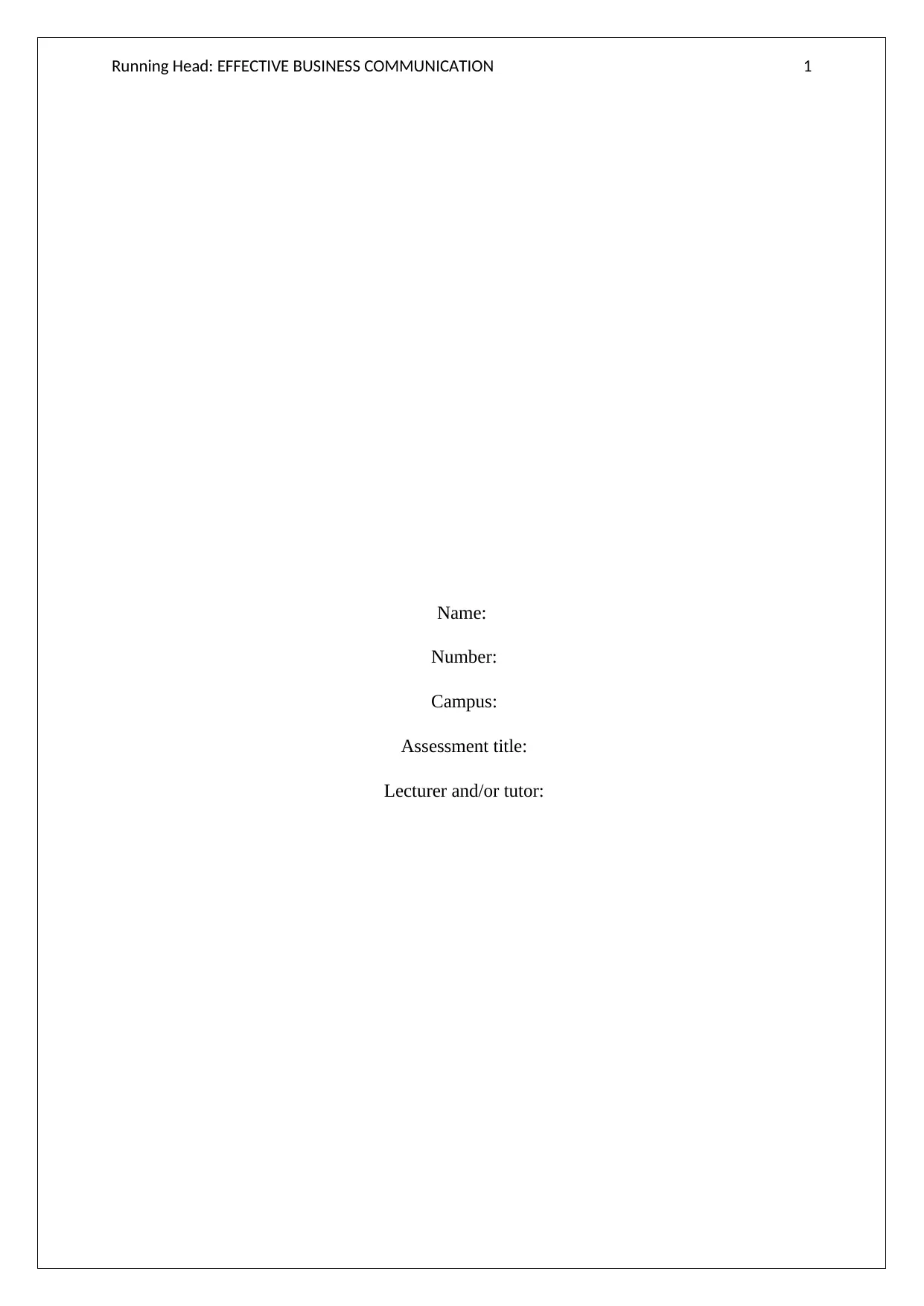
Running Head: EFFECTIVE BUSINESS COMMUNICATION 1
Name:
Number:
Campus:
Assessment title:
Lecturer and/or tutor:
Name:
Number:
Campus:
Assessment title:
Lecturer and/or tutor:
Paraphrase This Document
Need a fresh take? Get an instant paraphrase of this document with our AI Paraphraser
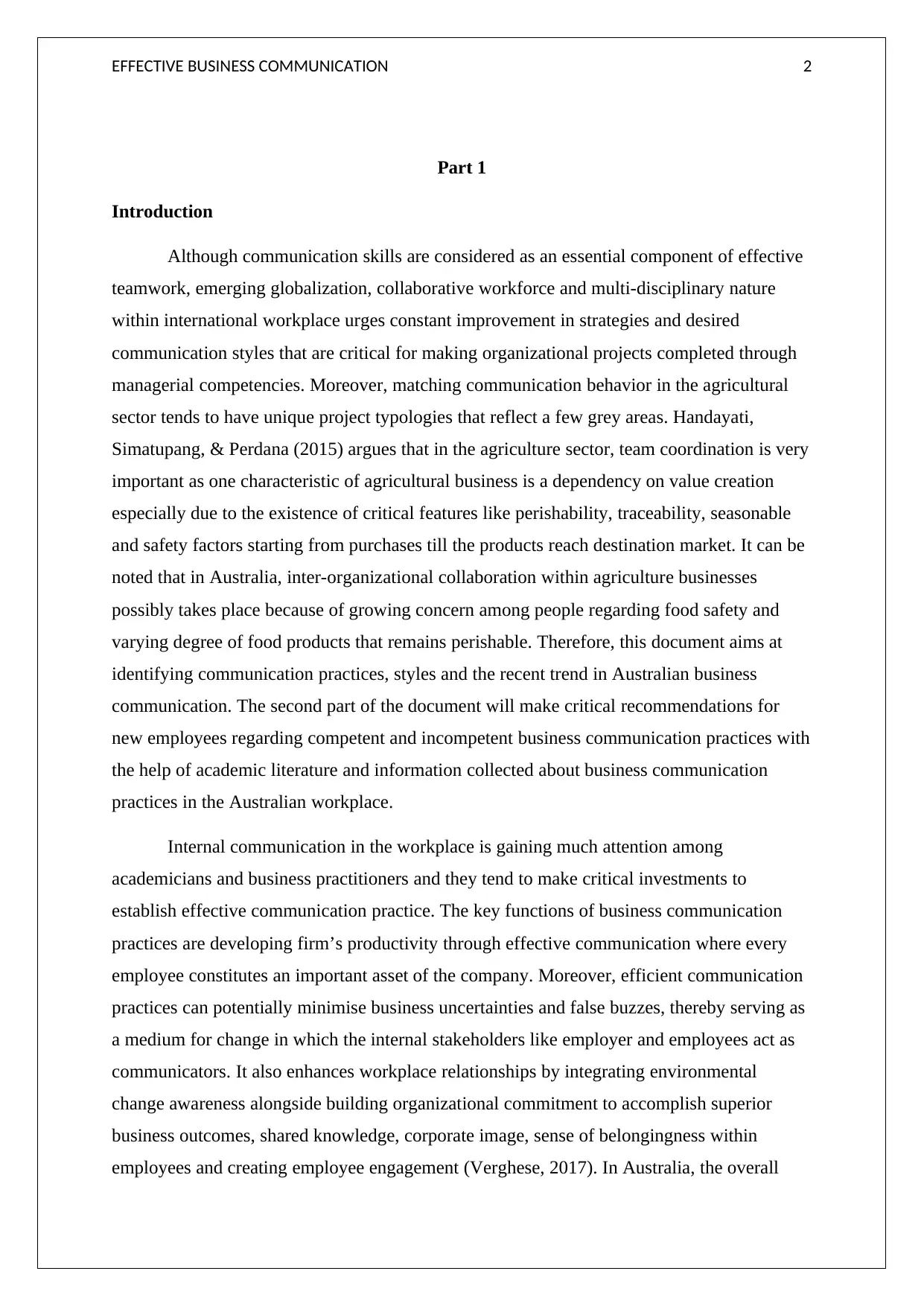
EFFECTIVE BUSINESS COMMUNICATION 2
Part 1
Introduction
Although communication skills are considered as an essential component of effective
teamwork, emerging globalization, collaborative workforce and multi-disciplinary nature
within international workplace urges constant improvement in strategies and desired
communication styles that are critical for making organizational projects completed through
managerial competencies. Moreover, matching communication behavior in the agricultural
sector tends to have unique project typologies that reflect a few grey areas. Handayati,
Simatupang, & Perdana (2015) argues that in the agriculture sector, team coordination is very
important as one characteristic of agricultural business is a dependency on value creation
especially due to the existence of critical features like perishability, traceability, seasonable
and safety factors starting from purchases till the products reach destination market. It can be
noted that in Australia, inter-organizational collaboration within agriculture businesses
possibly takes place because of growing concern among people regarding food safety and
varying degree of food products that remains perishable. Therefore, this document aims at
identifying communication practices, styles and the recent trend in Australian business
communication. The second part of the document will make critical recommendations for
new employees regarding competent and incompetent business communication practices with
the help of academic literature and information collected about business communication
practices in the Australian workplace.
Internal communication in the workplace is gaining much attention among
academicians and business practitioners and they tend to make critical investments to
establish effective communication practice. The key functions of business communication
practices are developing firm’s productivity through effective communication where every
employee constitutes an important asset of the company. Moreover, efficient communication
practices can potentially minimise business uncertainties and false buzzes, thereby serving as
a medium for change in which the internal stakeholders like employer and employees act as
communicators. It also enhances workplace relationships by integrating environmental
change awareness alongside building organizational commitment to accomplish superior
business outcomes, shared knowledge, corporate image, sense of belongingness within
employees and creating employee engagement (Verghese, 2017). In Australia, the overall
Part 1
Introduction
Although communication skills are considered as an essential component of effective
teamwork, emerging globalization, collaborative workforce and multi-disciplinary nature
within international workplace urges constant improvement in strategies and desired
communication styles that are critical for making organizational projects completed through
managerial competencies. Moreover, matching communication behavior in the agricultural
sector tends to have unique project typologies that reflect a few grey areas. Handayati,
Simatupang, & Perdana (2015) argues that in the agriculture sector, team coordination is very
important as one characteristic of agricultural business is a dependency on value creation
especially due to the existence of critical features like perishability, traceability, seasonable
and safety factors starting from purchases till the products reach destination market. It can be
noted that in Australia, inter-organizational collaboration within agriculture businesses
possibly takes place because of growing concern among people regarding food safety and
varying degree of food products that remains perishable. Therefore, this document aims at
identifying communication practices, styles and the recent trend in Australian business
communication. The second part of the document will make critical recommendations for
new employees regarding competent and incompetent business communication practices with
the help of academic literature and information collected about business communication
practices in the Australian workplace.
Internal communication in the workplace is gaining much attention among
academicians and business practitioners and they tend to make critical investments to
establish effective communication practice. The key functions of business communication
practices are developing firm’s productivity through effective communication where every
employee constitutes an important asset of the company. Moreover, efficient communication
practices can potentially minimise business uncertainties and false buzzes, thereby serving as
a medium for change in which the internal stakeholders like employer and employees act as
communicators. It also enhances workplace relationships by integrating environmental
change awareness alongside building organizational commitment to accomplish superior
business outcomes, shared knowledge, corporate image, sense of belongingness within
employees and creating employee engagement (Verghese, 2017). In Australia, the overall
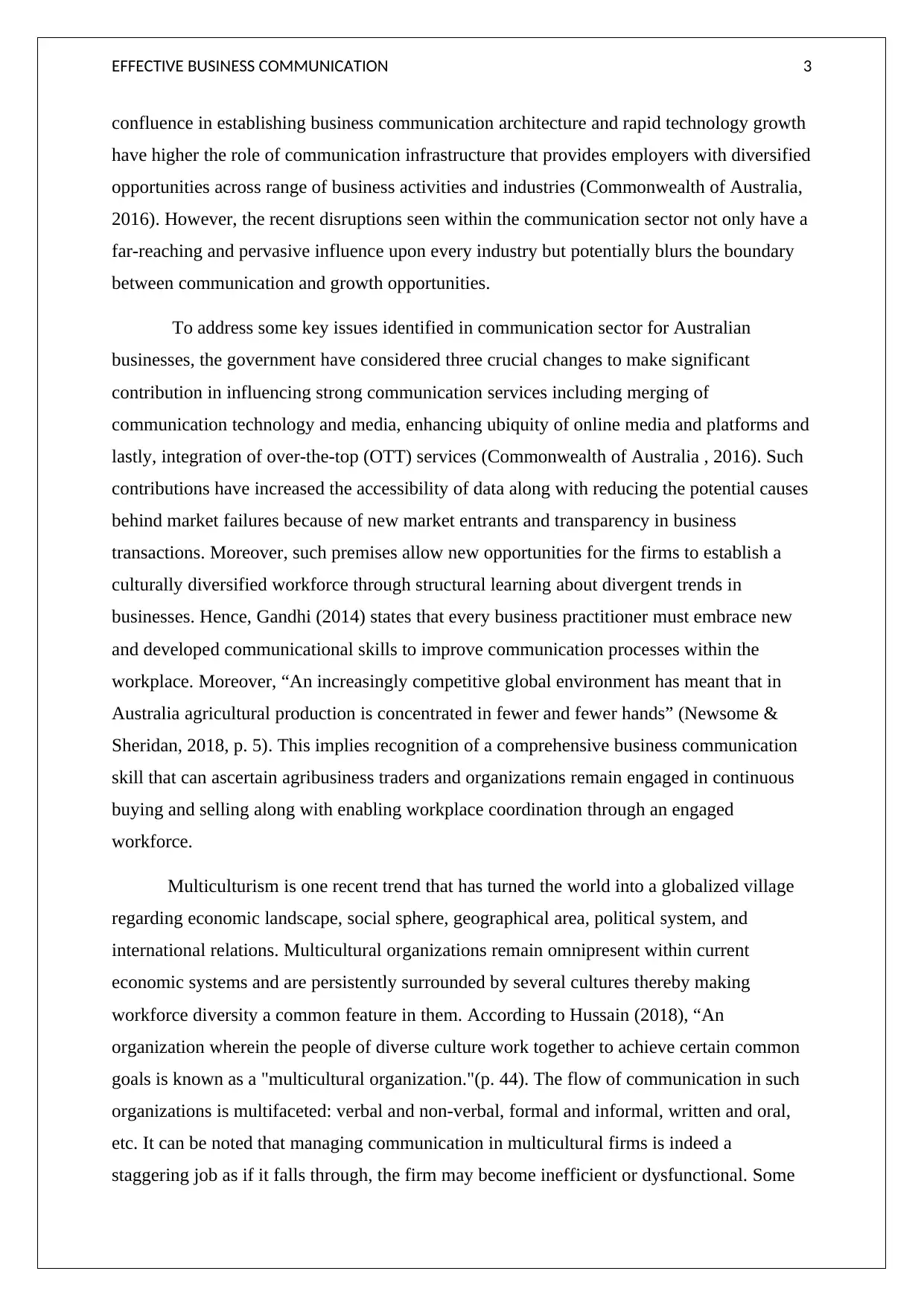
EFFECTIVE BUSINESS COMMUNICATION 3
confluence in establishing business communication architecture and rapid technology growth
have higher the role of communication infrastructure that provides employers with diversified
opportunities across range of business activities and industries (Commonwealth of Australia,
2016). However, the recent disruptions seen within the communication sector not only have a
far-reaching and pervasive influence upon every industry but potentially blurs the boundary
between communication and growth opportunities.
To address some key issues identified in communication sector for Australian
businesses, the government have considered three crucial changes to make significant
contribution in influencing strong communication services including merging of
communication technology and media, enhancing ubiquity of online media and platforms and
lastly, integration of over-the-top (OTT) services (Commonwealth of Australia , 2016). Such
contributions have increased the accessibility of data along with reducing the potential causes
behind market failures because of new market entrants and transparency in business
transactions. Moreover, such premises allow new opportunities for the firms to establish a
culturally diversified workforce through structural learning about divergent trends in
businesses. Hence, Gandhi (2014) states that every business practitioner must embrace new
and developed communicational skills to improve communication processes within the
workplace. Moreover, “An increasingly competitive global environment has meant that in
Australia agricultural production is concentrated in fewer and fewer hands” (Newsome &
Sheridan, 2018, p. 5). This implies recognition of a comprehensive business communication
skill that can ascertain agribusiness traders and organizations remain engaged in continuous
buying and selling along with enabling workplace coordination through an engaged
workforce.
Multiculturism is one recent trend that has turned the world into a globalized village
regarding economic landscape, social sphere, geographical area, political system, and
international relations. Multicultural organizations remain omnipresent within current
economic systems and are persistently surrounded by several cultures thereby making
workforce diversity a common feature in them. According to Hussain (2018), “An
organization wherein the people of diverse culture work together to achieve certain common
goals is known as a "multicultural organization."(p. 44). The flow of communication in such
organizations is multifaceted: verbal and non-verbal, formal and informal, written and oral,
etc. It can be noted that managing communication in multicultural firms is indeed a
staggering job as if it falls through, the firm may become inefficient or dysfunctional. Some
confluence in establishing business communication architecture and rapid technology growth
have higher the role of communication infrastructure that provides employers with diversified
opportunities across range of business activities and industries (Commonwealth of Australia,
2016). However, the recent disruptions seen within the communication sector not only have a
far-reaching and pervasive influence upon every industry but potentially blurs the boundary
between communication and growth opportunities.
To address some key issues identified in communication sector for Australian
businesses, the government have considered three crucial changes to make significant
contribution in influencing strong communication services including merging of
communication technology and media, enhancing ubiquity of online media and platforms and
lastly, integration of over-the-top (OTT) services (Commonwealth of Australia , 2016). Such
contributions have increased the accessibility of data along with reducing the potential causes
behind market failures because of new market entrants and transparency in business
transactions. Moreover, such premises allow new opportunities for the firms to establish a
culturally diversified workforce through structural learning about divergent trends in
businesses. Hence, Gandhi (2014) states that every business practitioner must embrace new
and developed communicational skills to improve communication processes within the
workplace. Moreover, “An increasingly competitive global environment has meant that in
Australia agricultural production is concentrated in fewer and fewer hands” (Newsome &
Sheridan, 2018, p. 5). This implies recognition of a comprehensive business communication
skill that can ascertain agribusiness traders and organizations remain engaged in continuous
buying and selling along with enabling workplace coordination through an engaged
workforce.
Multiculturism is one recent trend that has turned the world into a globalized village
regarding economic landscape, social sphere, geographical area, political system, and
international relations. Multicultural organizations remain omnipresent within current
economic systems and are persistently surrounded by several cultures thereby making
workforce diversity a common feature in them. According to Hussain (2018), “An
organization wherein the people of diverse culture work together to achieve certain common
goals is known as a "multicultural organization."(p. 44). The flow of communication in such
organizations is multifaceted: verbal and non-verbal, formal and informal, written and oral,
etc. It can be noted that managing communication in multicultural firms is indeed a
staggering job as if it falls through, the firm may become inefficient or dysfunctional. Some
⊘ This is a preview!⊘
Do you want full access?
Subscribe today to unlock all pages.

Trusted by 1+ million students worldwide
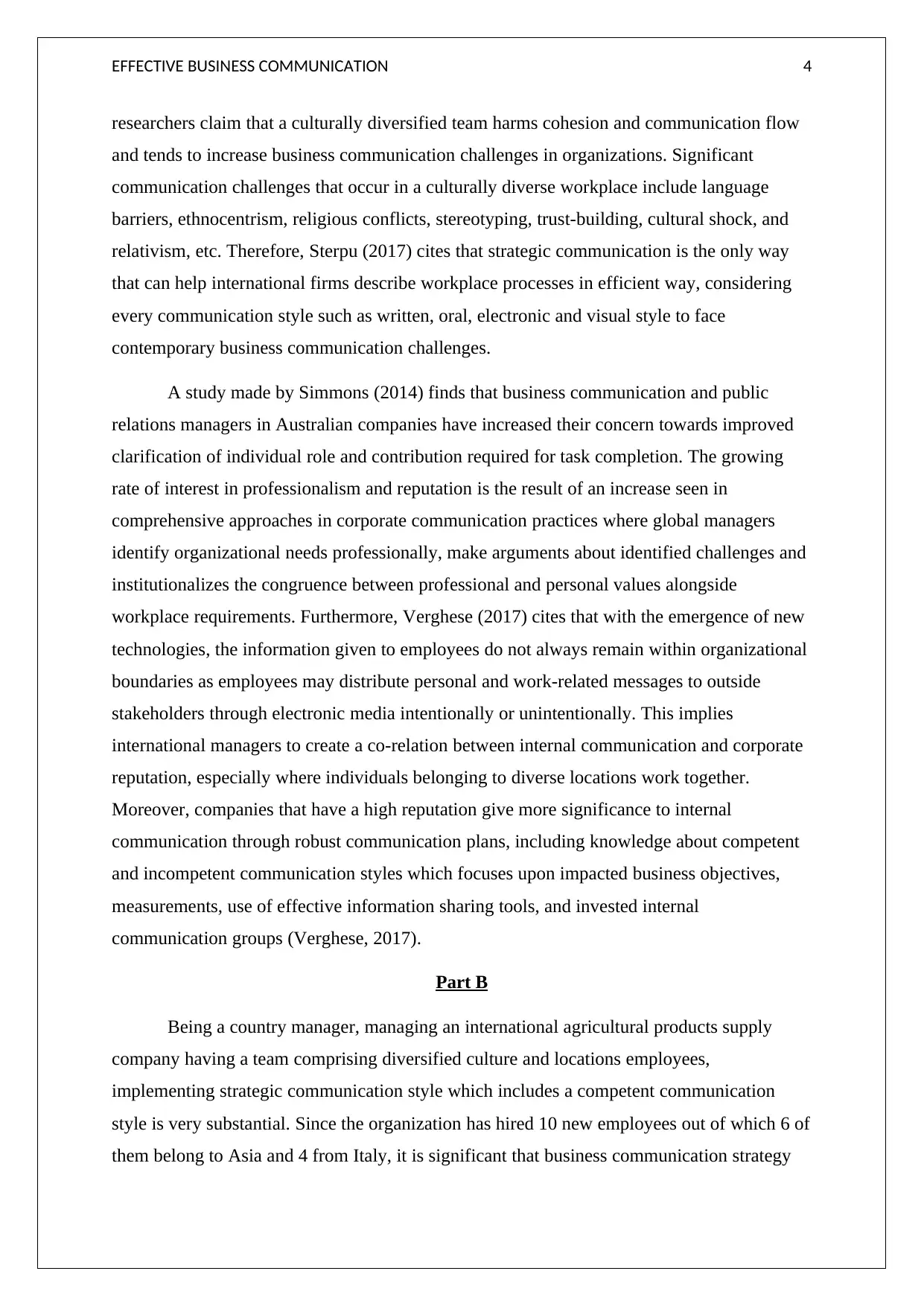
EFFECTIVE BUSINESS COMMUNICATION 4
researchers claim that a culturally diversified team harms cohesion and communication flow
and tends to increase business communication challenges in organizations. Significant
communication challenges that occur in a culturally diverse workplace include language
barriers, ethnocentrism, religious conflicts, stereotyping, trust-building, cultural shock, and
relativism, etc. Therefore, Sterpu (2017) cites that strategic communication is the only way
that can help international firms describe workplace processes in efficient way, considering
every communication style such as written, oral, electronic and visual style to face
contemporary business communication challenges.
A study made by Simmons (2014) finds that business communication and public
relations managers in Australian companies have increased their concern towards improved
clarification of individual role and contribution required for task completion. The growing
rate of interest in professionalism and reputation is the result of an increase seen in
comprehensive approaches in corporate communication practices where global managers
identify organizational needs professionally, make arguments about identified challenges and
institutionalizes the congruence between professional and personal values alongside
workplace requirements. Furthermore, Verghese (2017) cites that with the emergence of new
technologies, the information given to employees do not always remain within organizational
boundaries as employees may distribute personal and work-related messages to outside
stakeholders through electronic media intentionally or unintentionally. This implies
international managers to create a co-relation between internal communication and corporate
reputation, especially where individuals belonging to diverse locations work together.
Moreover, companies that have a high reputation give more significance to internal
communication through robust communication plans, including knowledge about competent
and incompetent communication styles which focuses upon impacted business objectives,
measurements, use of effective information sharing tools, and invested internal
communication groups (Verghese, 2017).
Part B
Being a country manager, managing an international agricultural products supply
company having a team comprising diversified culture and locations employees,
implementing strategic communication style which includes a competent communication
style is very substantial. Since the organization has hired 10 new employees out of which 6 of
them belong to Asia and 4 from Italy, it is significant that business communication strategy
researchers claim that a culturally diversified team harms cohesion and communication flow
and tends to increase business communication challenges in organizations. Significant
communication challenges that occur in a culturally diverse workplace include language
barriers, ethnocentrism, religious conflicts, stereotyping, trust-building, cultural shock, and
relativism, etc. Therefore, Sterpu (2017) cites that strategic communication is the only way
that can help international firms describe workplace processes in efficient way, considering
every communication style such as written, oral, electronic and visual style to face
contemporary business communication challenges.
A study made by Simmons (2014) finds that business communication and public
relations managers in Australian companies have increased their concern towards improved
clarification of individual role and contribution required for task completion. The growing
rate of interest in professionalism and reputation is the result of an increase seen in
comprehensive approaches in corporate communication practices where global managers
identify organizational needs professionally, make arguments about identified challenges and
institutionalizes the congruence between professional and personal values alongside
workplace requirements. Furthermore, Verghese (2017) cites that with the emergence of new
technologies, the information given to employees do not always remain within organizational
boundaries as employees may distribute personal and work-related messages to outside
stakeholders through electronic media intentionally or unintentionally. This implies
international managers to create a co-relation between internal communication and corporate
reputation, especially where individuals belonging to diverse locations work together.
Moreover, companies that have a high reputation give more significance to internal
communication through robust communication plans, including knowledge about competent
and incompetent communication styles which focuses upon impacted business objectives,
measurements, use of effective information sharing tools, and invested internal
communication groups (Verghese, 2017).
Part B
Being a country manager, managing an international agricultural products supply
company having a team comprising diversified culture and locations employees,
implementing strategic communication style which includes a competent communication
style is very substantial. Since the organization has hired 10 new employees out of which 6 of
them belong to Asia and 4 from Italy, it is significant that business communication strategy
Paraphrase This Document
Need a fresh take? Get an instant paraphrase of this document with our AI Paraphraser
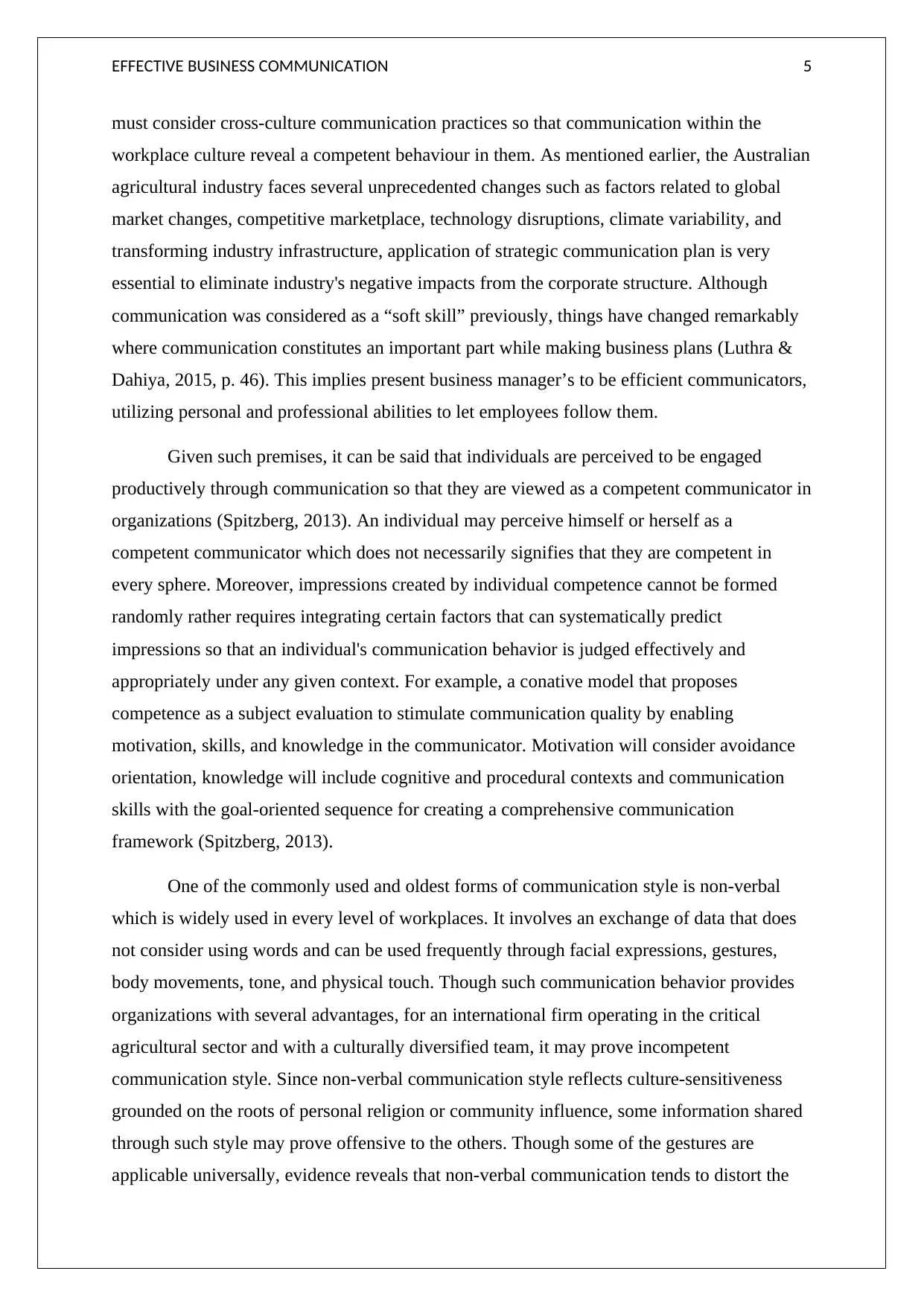
EFFECTIVE BUSINESS COMMUNICATION 5
must consider cross-culture communication practices so that communication within the
workplace culture reveal a competent behaviour in them. As mentioned earlier, the Australian
agricultural industry faces several unprecedented changes such as factors related to global
market changes, competitive marketplace, technology disruptions, climate variability, and
transforming industry infrastructure, application of strategic communication plan is very
essential to eliminate industry's negative impacts from the corporate structure. Although
communication was considered as a “soft skill” previously, things have changed remarkably
where communication constitutes an important part while making business plans (Luthra &
Dahiya, 2015, p. 46). This implies present business manager’s to be efficient communicators,
utilizing personal and professional abilities to let employees follow them.
Given such premises, it can be said that individuals are perceived to be engaged
productively through communication so that they are viewed as a competent communicator in
organizations (Spitzberg, 2013). An individual may perceive himself or herself as a
competent communicator which does not necessarily signifies that they are competent in
every sphere. Moreover, impressions created by individual competence cannot be formed
randomly rather requires integrating certain factors that can systematically predict
impressions so that an individual's communication behavior is judged effectively and
appropriately under any given context. For example, a conative model that proposes
competence as a subject evaluation to stimulate communication quality by enabling
motivation, skills, and knowledge in the communicator. Motivation will consider avoidance
orientation, knowledge will include cognitive and procedural contexts and communication
skills with the goal-oriented sequence for creating a comprehensive communication
framework (Spitzberg, 2013).
One of the commonly used and oldest forms of communication style is non-verbal
which is widely used in every level of workplaces. It involves an exchange of data that does
not consider using words and can be used frequently through facial expressions, gestures,
body movements, tone, and physical touch. Though such communication behavior provides
organizations with several advantages, for an international firm operating in the critical
agricultural sector and with a culturally diversified team, it may prove incompetent
communication style. Since non-verbal communication style reflects culture-sensitiveness
grounded on the roots of personal religion or community influence, some information shared
through such style may prove offensive to the others. Though some of the gestures are
applicable universally, evidence reveals that non-verbal communication tends to distort the
must consider cross-culture communication practices so that communication within the
workplace culture reveal a competent behaviour in them. As mentioned earlier, the Australian
agricultural industry faces several unprecedented changes such as factors related to global
market changes, competitive marketplace, technology disruptions, climate variability, and
transforming industry infrastructure, application of strategic communication plan is very
essential to eliminate industry's negative impacts from the corporate structure. Although
communication was considered as a “soft skill” previously, things have changed remarkably
where communication constitutes an important part while making business plans (Luthra &
Dahiya, 2015, p. 46). This implies present business manager’s to be efficient communicators,
utilizing personal and professional abilities to let employees follow them.
Given such premises, it can be said that individuals are perceived to be engaged
productively through communication so that they are viewed as a competent communicator in
organizations (Spitzberg, 2013). An individual may perceive himself or herself as a
competent communicator which does not necessarily signifies that they are competent in
every sphere. Moreover, impressions created by individual competence cannot be formed
randomly rather requires integrating certain factors that can systematically predict
impressions so that an individual's communication behavior is judged effectively and
appropriately under any given context. For example, a conative model that proposes
competence as a subject evaluation to stimulate communication quality by enabling
motivation, skills, and knowledge in the communicator. Motivation will consider avoidance
orientation, knowledge will include cognitive and procedural contexts and communication
skills with the goal-oriented sequence for creating a comprehensive communication
framework (Spitzberg, 2013).
One of the commonly used and oldest forms of communication style is non-verbal
which is widely used in every level of workplaces. It involves an exchange of data that does
not consider using words and can be used frequently through facial expressions, gestures,
body movements, tone, and physical touch. Though such communication behavior provides
organizations with several advantages, for an international firm operating in the critical
agricultural sector and with a culturally diversified team, it may prove incompetent
communication style. Since non-verbal communication style reflects culture-sensitiveness
grounded on the roots of personal religion or community influence, some information shared
through such style may prove offensive to the others. Though some of the gestures are
applicable universally, evidence reveals that non-verbal communication tends to distort the
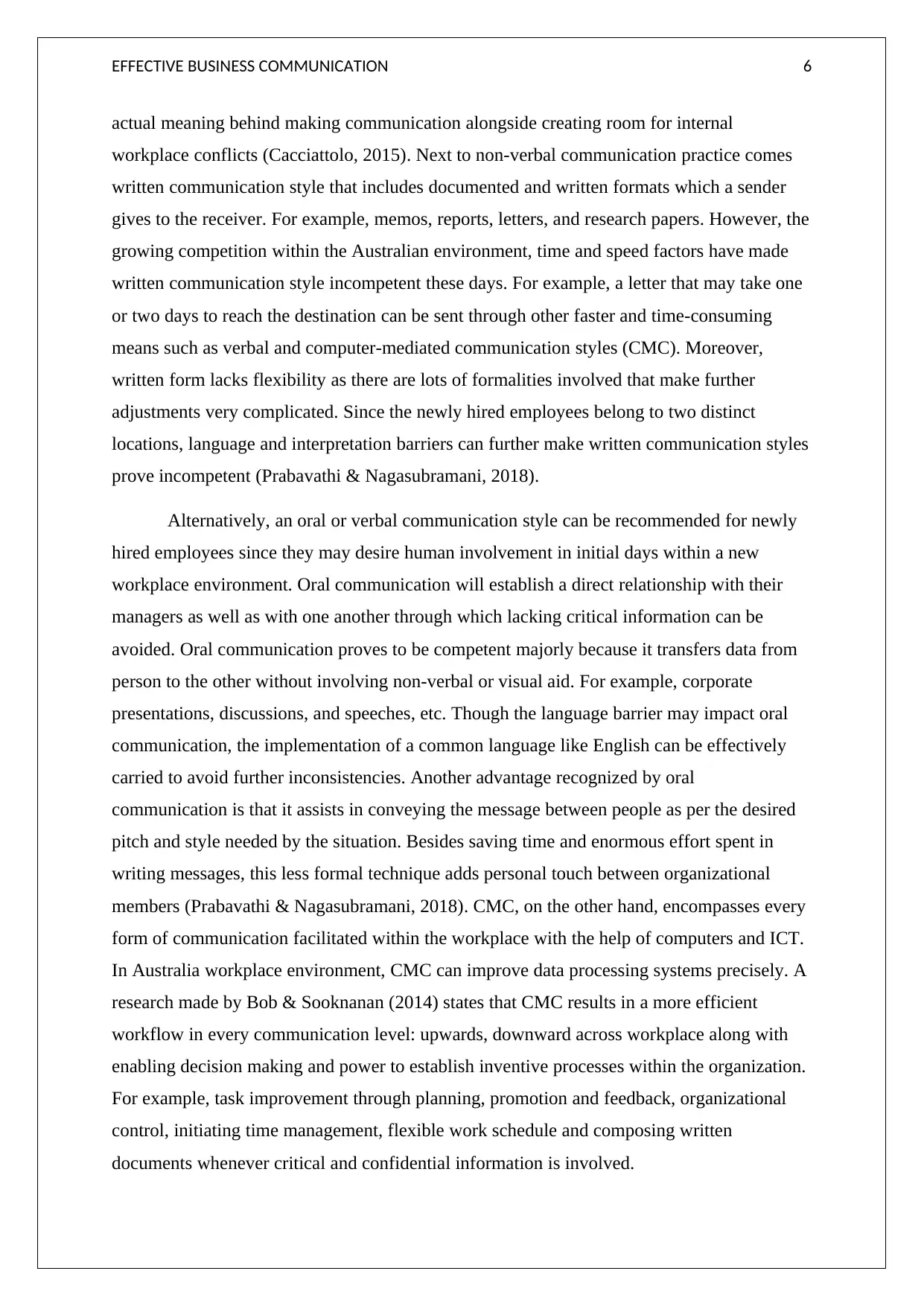
EFFECTIVE BUSINESS COMMUNICATION 6
actual meaning behind making communication alongside creating room for internal
workplace conflicts (Cacciattolo, 2015). Next to non-verbal communication practice comes
written communication style that includes documented and written formats which a sender
gives to the receiver. For example, memos, reports, letters, and research papers. However, the
growing competition within the Australian environment, time and speed factors have made
written communication style incompetent these days. For example, a letter that may take one
or two days to reach the destination can be sent through other faster and time-consuming
means such as verbal and computer-mediated communication styles (CMC). Moreover,
written form lacks flexibility as there are lots of formalities involved that make further
adjustments very complicated. Since the newly hired employees belong to two distinct
locations, language and interpretation barriers can further make written communication styles
prove incompetent (Prabavathi & Nagasubramani, 2018).
Alternatively, an oral or verbal communication style can be recommended for newly
hired employees since they may desire human involvement in initial days within a new
workplace environment. Oral communication will establish a direct relationship with their
managers as well as with one another through which lacking critical information can be
avoided. Oral communication proves to be competent majorly because it transfers data from
person to the other without involving non-verbal or visual aid. For example, corporate
presentations, discussions, and speeches, etc. Though the language barrier may impact oral
communication, the implementation of a common language like English can be effectively
carried to avoid further inconsistencies. Another advantage recognized by oral
communication is that it assists in conveying the message between people as per the desired
pitch and style needed by the situation. Besides saving time and enormous effort spent in
writing messages, this less formal technique adds personal touch between organizational
members (Prabavathi & Nagasubramani, 2018). CMC, on the other hand, encompasses every
form of communication facilitated within the workplace with the help of computers and ICT.
In Australia workplace environment, CMC can improve data processing systems precisely. A
research made by Bob & Sooknanan (2014) states that CMC results in a more efficient
workflow in every communication level: upwards, downward across workplace along with
enabling decision making and power to establish inventive processes within the organization.
For example, task improvement through planning, promotion and feedback, organizational
control, initiating time management, flexible work schedule and composing written
documents whenever critical and confidential information is involved.
actual meaning behind making communication alongside creating room for internal
workplace conflicts (Cacciattolo, 2015). Next to non-verbal communication practice comes
written communication style that includes documented and written formats which a sender
gives to the receiver. For example, memos, reports, letters, and research papers. However, the
growing competition within the Australian environment, time and speed factors have made
written communication style incompetent these days. For example, a letter that may take one
or two days to reach the destination can be sent through other faster and time-consuming
means such as verbal and computer-mediated communication styles (CMC). Moreover,
written form lacks flexibility as there are lots of formalities involved that make further
adjustments very complicated. Since the newly hired employees belong to two distinct
locations, language and interpretation barriers can further make written communication styles
prove incompetent (Prabavathi & Nagasubramani, 2018).
Alternatively, an oral or verbal communication style can be recommended for newly
hired employees since they may desire human involvement in initial days within a new
workplace environment. Oral communication will establish a direct relationship with their
managers as well as with one another through which lacking critical information can be
avoided. Oral communication proves to be competent majorly because it transfers data from
person to the other without involving non-verbal or visual aid. For example, corporate
presentations, discussions, and speeches, etc. Though the language barrier may impact oral
communication, the implementation of a common language like English can be effectively
carried to avoid further inconsistencies. Another advantage recognized by oral
communication is that it assists in conveying the message between people as per the desired
pitch and style needed by the situation. Besides saving time and enormous effort spent in
writing messages, this less formal technique adds personal touch between organizational
members (Prabavathi & Nagasubramani, 2018). CMC, on the other hand, encompasses every
form of communication facilitated within the workplace with the help of computers and ICT.
In Australia workplace environment, CMC can improve data processing systems precisely. A
research made by Bob & Sooknanan (2014) states that CMC results in a more efficient
workflow in every communication level: upwards, downward across workplace along with
enabling decision making and power to establish inventive processes within the organization.
For example, task improvement through planning, promotion and feedback, organizational
control, initiating time management, flexible work schedule and composing written
documents whenever critical and confidential information is involved.
⊘ This is a preview!⊘
Do you want full access?
Subscribe today to unlock all pages.

Trusted by 1+ million students worldwide
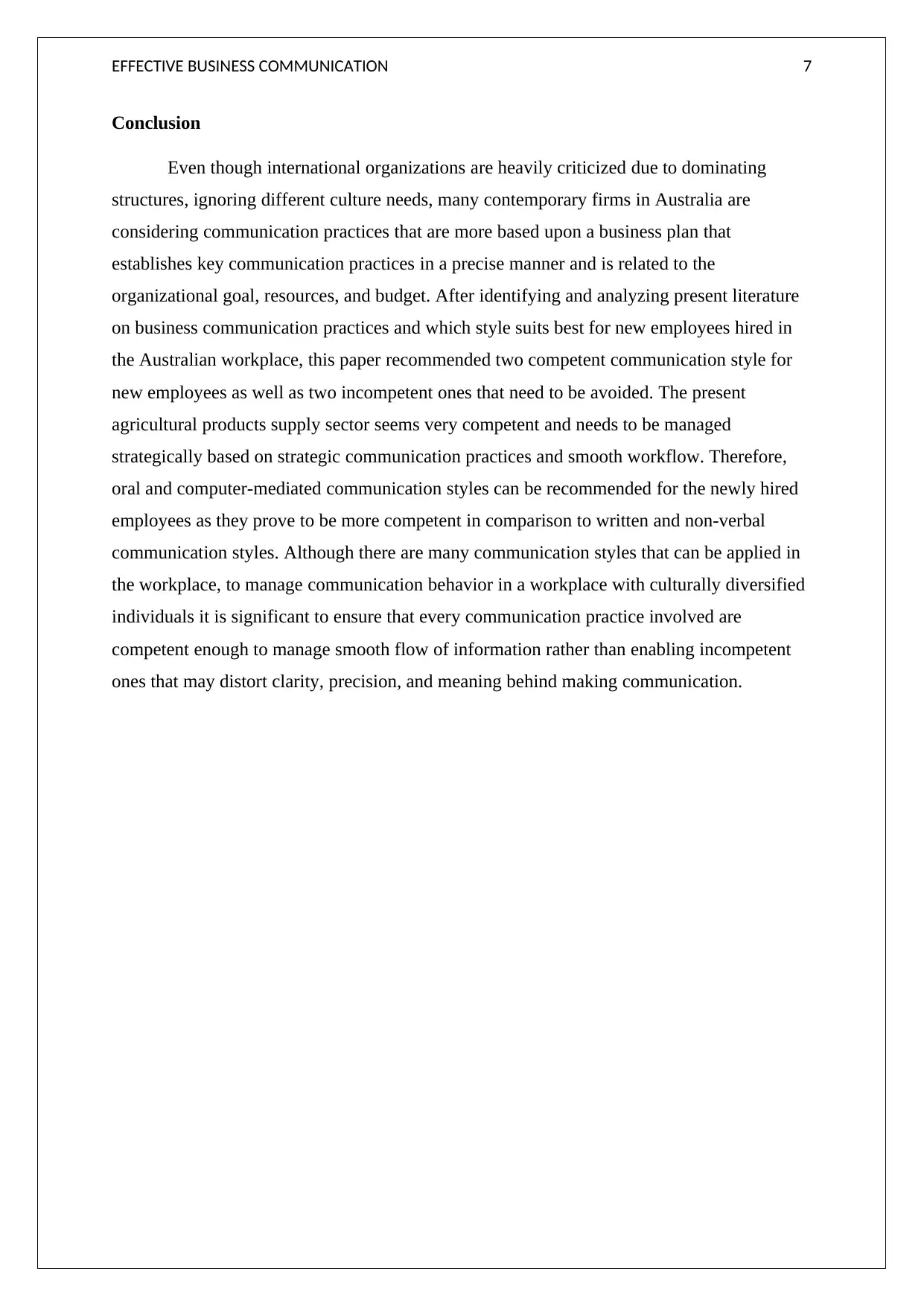
EFFECTIVE BUSINESS COMMUNICATION 7
Conclusion
Even though international organizations are heavily criticized due to dominating
structures, ignoring different culture needs, many contemporary firms in Australia are
considering communication practices that are more based upon a business plan that
establishes key communication practices in a precise manner and is related to the
organizational goal, resources, and budget. After identifying and analyzing present literature
on business communication practices and which style suits best for new employees hired in
the Australian workplace, this paper recommended two competent communication style for
new employees as well as two incompetent ones that need to be avoided. The present
agricultural products supply sector seems very competent and needs to be managed
strategically based on strategic communication practices and smooth workflow. Therefore,
oral and computer-mediated communication styles can be recommended for the newly hired
employees as they prove to be more competent in comparison to written and non-verbal
communication styles. Although there are many communication styles that can be applied in
the workplace, to manage communication behavior in a workplace with culturally diversified
individuals it is significant to ensure that every communication practice involved are
competent enough to manage smooth flow of information rather than enabling incompetent
ones that may distort clarity, precision, and meaning behind making communication.
Conclusion
Even though international organizations are heavily criticized due to dominating
structures, ignoring different culture needs, many contemporary firms in Australia are
considering communication practices that are more based upon a business plan that
establishes key communication practices in a precise manner and is related to the
organizational goal, resources, and budget. After identifying and analyzing present literature
on business communication practices and which style suits best for new employees hired in
the Australian workplace, this paper recommended two competent communication style for
new employees as well as two incompetent ones that need to be avoided. The present
agricultural products supply sector seems very competent and needs to be managed
strategically based on strategic communication practices and smooth workflow. Therefore,
oral and computer-mediated communication styles can be recommended for the newly hired
employees as they prove to be more competent in comparison to written and non-verbal
communication styles. Although there are many communication styles that can be applied in
the workplace, to manage communication behavior in a workplace with culturally diversified
individuals it is significant to ensure that every communication practice involved are
competent enough to manage smooth flow of information rather than enabling incompetent
ones that may distort clarity, precision, and meaning behind making communication.
Paraphrase This Document
Need a fresh take? Get an instant paraphrase of this document with our AI Paraphraser
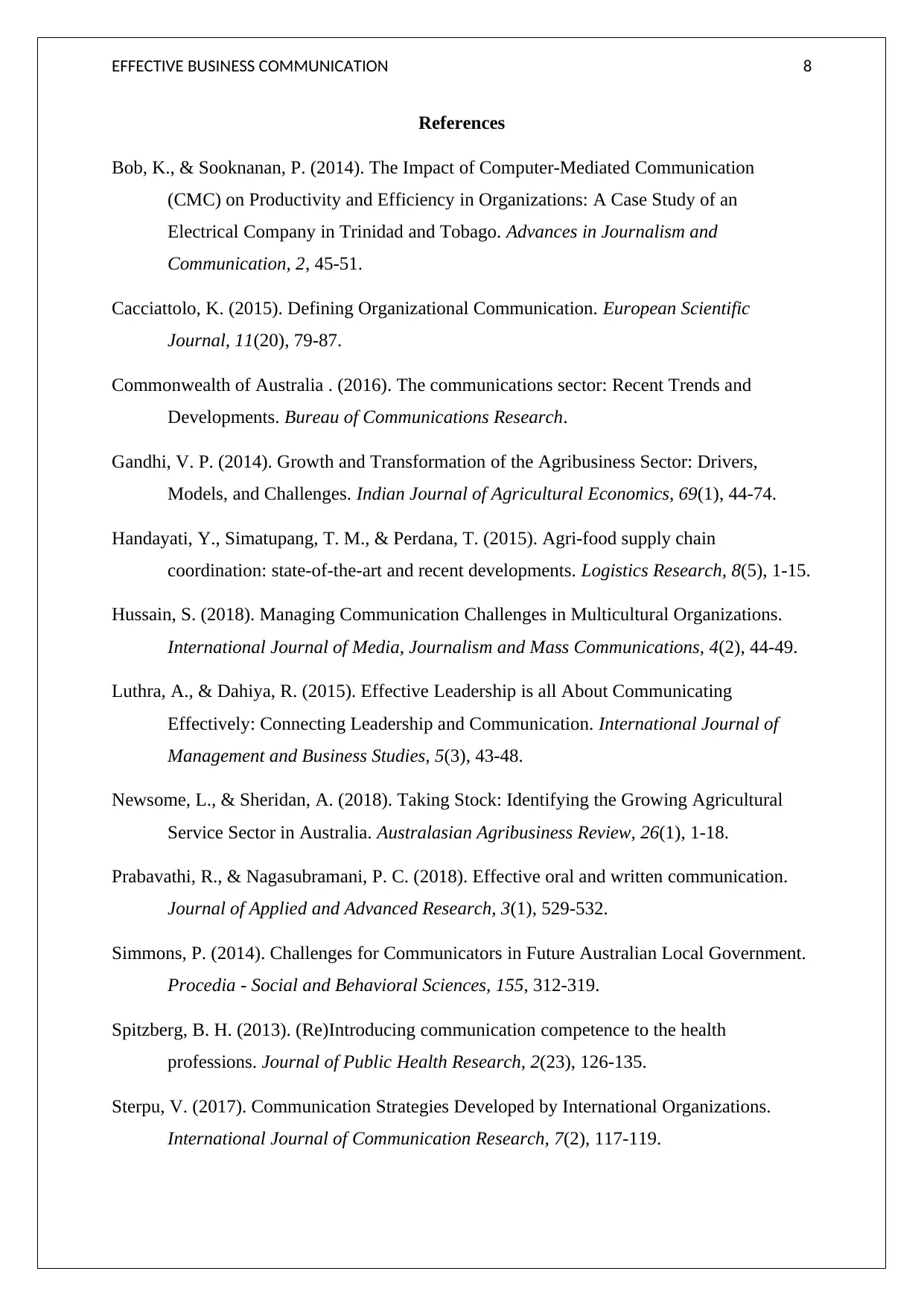
EFFECTIVE BUSINESS COMMUNICATION 8
References
Bob, K., & Sooknanan, P. (2014). The Impact of Computer-Mediated Communication
(CMC) on Productivity and Efficiency in Organizations: A Case Study of an
Electrical Company in Trinidad and Tobago. Advances in Journalism and
Communication, 2, 45-51.
Cacciattolo, K. (2015). Defining Organizational Communication. European Scientific
Journal, 11(20), 79-87.
Commonwealth of Australia . (2016). The communications sector: Recent Trends and
Developments. Bureau of Communications Research.
Gandhi, V. P. (2014). Growth and Transformation of the Agribusiness Sector: Drivers,
Models, and Challenges. Indian Journal of Agricultural Economics, 69(1), 44-74.
Handayati, Y., Simatupang, T. M., & Perdana, T. (2015). Agri-food supply chain
coordination: state-of-the-art and recent developments. Logistics Research, 8(5), 1-15.
Hussain, S. (2018). Managing Communication Challenges in Multicultural Organizations.
International Journal of Media, Journalism and Mass Communications, 4(2), 44-49.
Luthra, A., & Dahiya, R. (2015). Effective Leadership is all About Communicating
Effectively: Connecting Leadership and Communication. International Journal of
Management and Business Studies, 5(3), 43-48.
Newsome, L., & Sheridan, A. (2018). Taking Stock: Identifying the Growing Agricultural
Service Sector in Australia. Australasian Agribusiness Review, 26(1), 1-18.
Prabavathi, R., & Nagasubramani, P. C. (2018). Effective oral and written communication.
Journal of Applied and Advanced Research, 3(1), 529-532.
Simmons, P. (2014). Challenges for Communicators in Future Australian Local Government.
Procedia - Social and Behavioral Sciences, 155, 312-319.
Spitzberg, B. H. (2013). (Re)Introducing communication competence to the health
professions. Journal of Public Health Research, 2(23), 126-135.
Sterpu, V. (2017). Communication Strategies Developed by International Organizations.
International Journal of Communication Research, 7(2), 117-119.
References
Bob, K., & Sooknanan, P. (2014). The Impact of Computer-Mediated Communication
(CMC) on Productivity and Efficiency in Organizations: A Case Study of an
Electrical Company in Trinidad and Tobago. Advances in Journalism and
Communication, 2, 45-51.
Cacciattolo, K. (2015). Defining Organizational Communication. European Scientific
Journal, 11(20), 79-87.
Commonwealth of Australia . (2016). The communications sector: Recent Trends and
Developments. Bureau of Communications Research.
Gandhi, V. P. (2014). Growth and Transformation of the Agribusiness Sector: Drivers,
Models, and Challenges. Indian Journal of Agricultural Economics, 69(1), 44-74.
Handayati, Y., Simatupang, T. M., & Perdana, T. (2015). Agri-food supply chain
coordination: state-of-the-art and recent developments. Logistics Research, 8(5), 1-15.
Hussain, S. (2018). Managing Communication Challenges in Multicultural Organizations.
International Journal of Media, Journalism and Mass Communications, 4(2), 44-49.
Luthra, A., & Dahiya, R. (2015). Effective Leadership is all About Communicating
Effectively: Connecting Leadership and Communication. International Journal of
Management and Business Studies, 5(3), 43-48.
Newsome, L., & Sheridan, A. (2018). Taking Stock: Identifying the Growing Agricultural
Service Sector in Australia. Australasian Agribusiness Review, 26(1), 1-18.
Prabavathi, R., & Nagasubramani, P. C. (2018). Effective oral and written communication.
Journal of Applied and Advanced Research, 3(1), 529-532.
Simmons, P. (2014). Challenges for Communicators in Future Australian Local Government.
Procedia - Social and Behavioral Sciences, 155, 312-319.
Spitzberg, B. H. (2013). (Re)Introducing communication competence to the health
professions. Journal of Public Health Research, 2(23), 126-135.
Sterpu, V. (2017). Communication Strategies Developed by International Organizations.
International Journal of Communication Research, 7(2), 117-119.
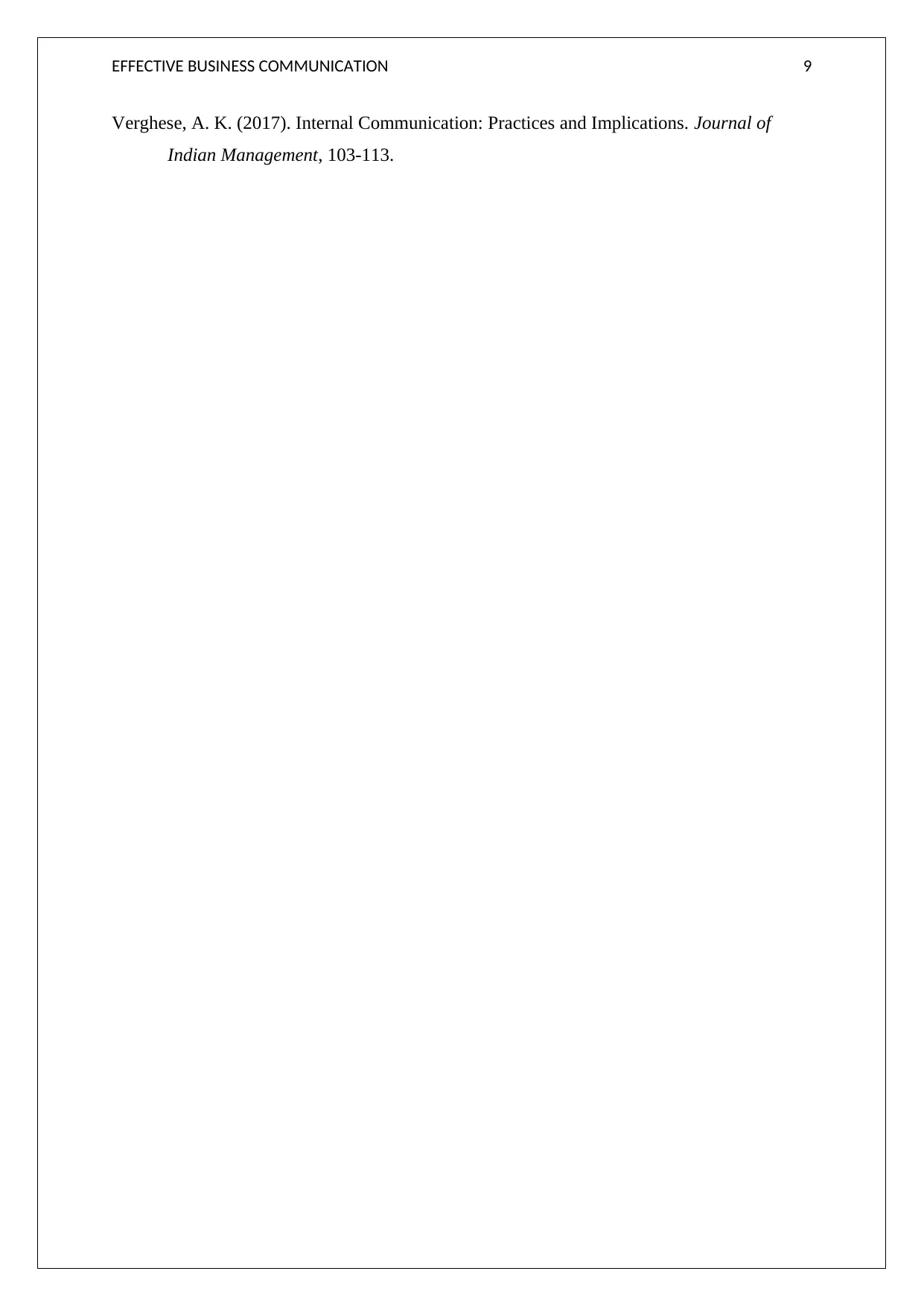
EFFECTIVE BUSINESS COMMUNICATION 9
Verghese, A. K. (2017). Internal Communication: Practices and Implications. Journal of
Indian Management, 103-113.
Verghese, A. K. (2017). Internal Communication: Practices and Implications. Journal of
Indian Management, 103-113.
⊘ This is a preview!⊘
Do you want full access?
Subscribe today to unlock all pages.

Trusted by 1+ million students worldwide
1 out of 9
Related Documents
Your All-in-One AI-Powered Toolkit for Academic Success.
+13062052269
info@desklib.com
Available 24*7 on WhatsApp / Email
![[object Object]](/_next/static/media/star-bottom.7253800d.svg)
Unlock your academic potential
Copyright © 2020–2025 A2Z Services. All Rights Reserved. Developed and managed by ZUCOL.





